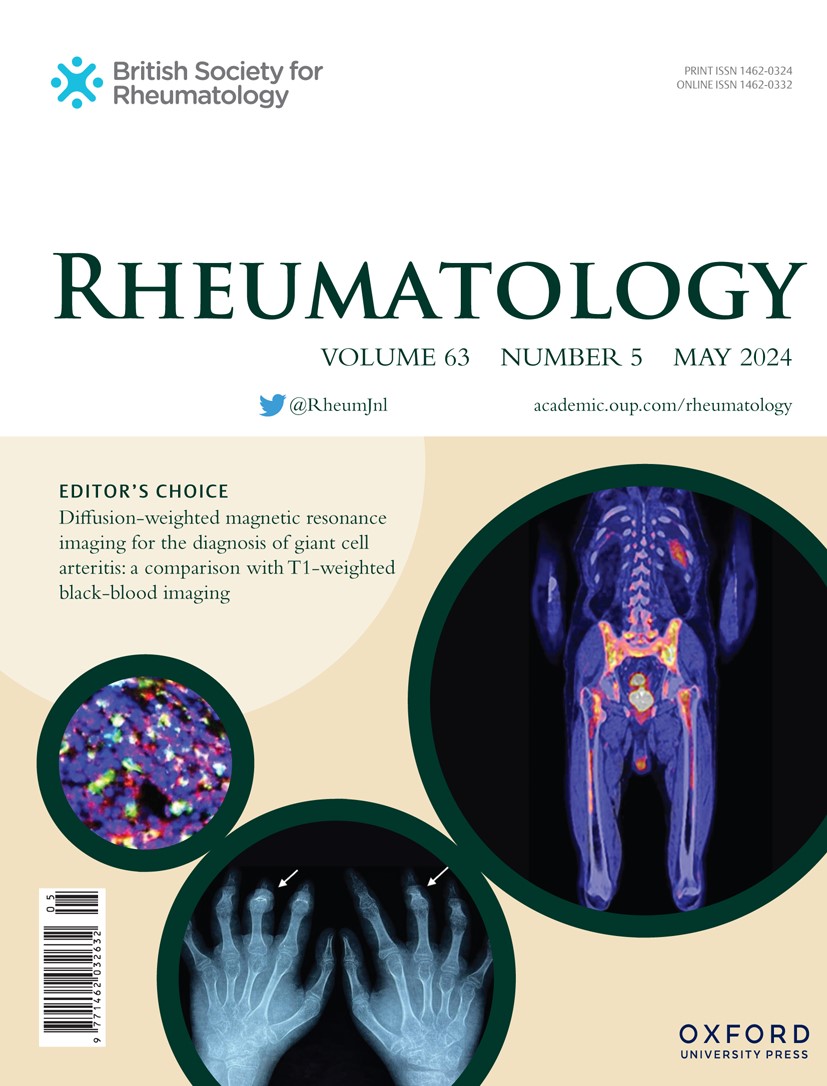Association of clinical and sonographic factors with discrepancy between patients' and evaluators' global assessments in psoriatic arthritis.
IF 4.7
2区 医学
Q1 RHEUMATOLOGY
引用次数: 0
Abstract
OBJECTIVES To evaluate the discordance between patients' global assessments (PGA) and evaluators' global assessments (EGA) in psoriatic arthritis (PsA), and to explore the association of clinical variables, patient-reported outcomes (PROs), and ultrasound (US) factors with this discordance. METHODS Consecutive PsA patients (CASPAR criteria) were prospectively recruited and evaluated by a comprehensive clinical examination, PROs and sonographic assessment (including 52 joints, 40 tendons and 14 entheses). EGA was scored by rheumatologists blinded to the PGA. Discordance between PGA and EGA was considered significant if the delta was ≥3. The US assessor was blinded to the clinical data. The concordant and discordant groups were compared, and factors associated with discordance were evaluated through a multivariate regression analysis. RESULTS Of the 158 PsA patients who were included, 88 (55.7%) patients were considered discordant, with the mean difference between PGA and EGA of 3.3. The discordant group had significantly higher tender joint counts (TJC), enthesitis, C-reactive protein (CRP), and lower working status rates compared with the concordant group (p < 0.05). US scores were similar between the groups. Patients with discordance had significantly higher PsA activity scores, a higher prevalence of fibromyalgia, and worse PROs, including pain, depression, fatigue and measures of quality of life (p < 0.05). On multivariate regression, higher TJC, lower swollen joint counts and depression were associated with greater discordance (OR 1.07, OR 0.85 and OR 1.05, respectively, p < 0.05). CONCLUSION The discrepancy between PGA and EGA in PsA is characterized by worse disease activity scores and worse subjective measures but not by sonographic measures.银屑病关节炎临床和超声因素与患者和评估者总体评估差异的关系。
目的评价银屑病关节炎(PsA)患者总体评估(PGA)与评估者总体评估(EGA)之间的不一致性,并探讨临床变量、患者报告结局(PROs)和超声(US)因素与这种不一致性的关系。方法前瞻性招募连续PsA患者(CASPAR标准),通过综合临床检查、PROs和超声评估(包括52个关节、40个肌腱和14个关节)进行评估。EGA由对PGA不知情的风湿病学家评分。δ≥3时PGA与EGA被认为是显著的不一致。美国评估人员对临床数据不知情。比较一致性组和不一致性组,并通过多元回归分析评估不一致性相关因素。结果纳入的158例PsA患者中,88例(55.7%)患者被认为不一致,PGA和EGA的平均差异为3.3。不协调组的压痛关节计数(TJC)、炎症、c反应蛋白(CRP)显著高于协调组,工作状态率显著低于协调组(p < 0.05)。美国的得分在两组之间相似。不一致的患者PsA活性评分明显更高,纤维肌痛患病率更高,疼痛、抑郁、疲劳和生活质量指标等不良评价更差(p < 0.05)。在多变量回归中,较高的TJC、较低的肿胀关节计数和凹陷与较大的不一致性相关(OR分别为1.07、0.85和1.05,p < 0.05)。结论PGA和EGA在PsA中的差异表现为疾病活动性评分差和主观测量差,超声测量不存在差异。
本文章由计算机程序翻译,如有差异,请以英文原文为准。
求助全文
约1分钟内获得全文
求助全文
来源期刊

Rheumatology
医学-风湿病学
CiteScore
9.40
自引率
7.30%
发文量
1091
审稿时长
2 months
期刊介绍:
Rheumatology strives to support research and discovery by publishing the highest quality original scientific papers with a focus on basic, clinical and translational research. The journal’s subject areas cover a wide range of paediatric and adult rheumatological conditions from an international perspective. It is an official journal of the British Society for Rheumatology, published by Oxford University Press.
Rheumatology publishes original articles, reviews, editorials, guidelines, concise reports, meta-analyses, original case reports, clinical vignettes, letters and matters arising from published material. The journal takes pride in serving the global rheumatology community, with a focus on high societal impact in the form of podcasts, videos and extended social media presence, and utilizing metrics such as Altmetric. Keep up to date by following the journal on Twitter @RheumJnl.
 求助内容:
求助内容: 应助结果提醒方式:
应助结果提醒方式:


